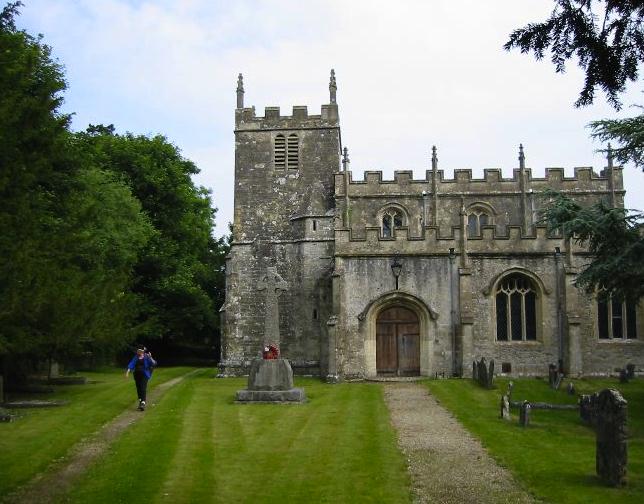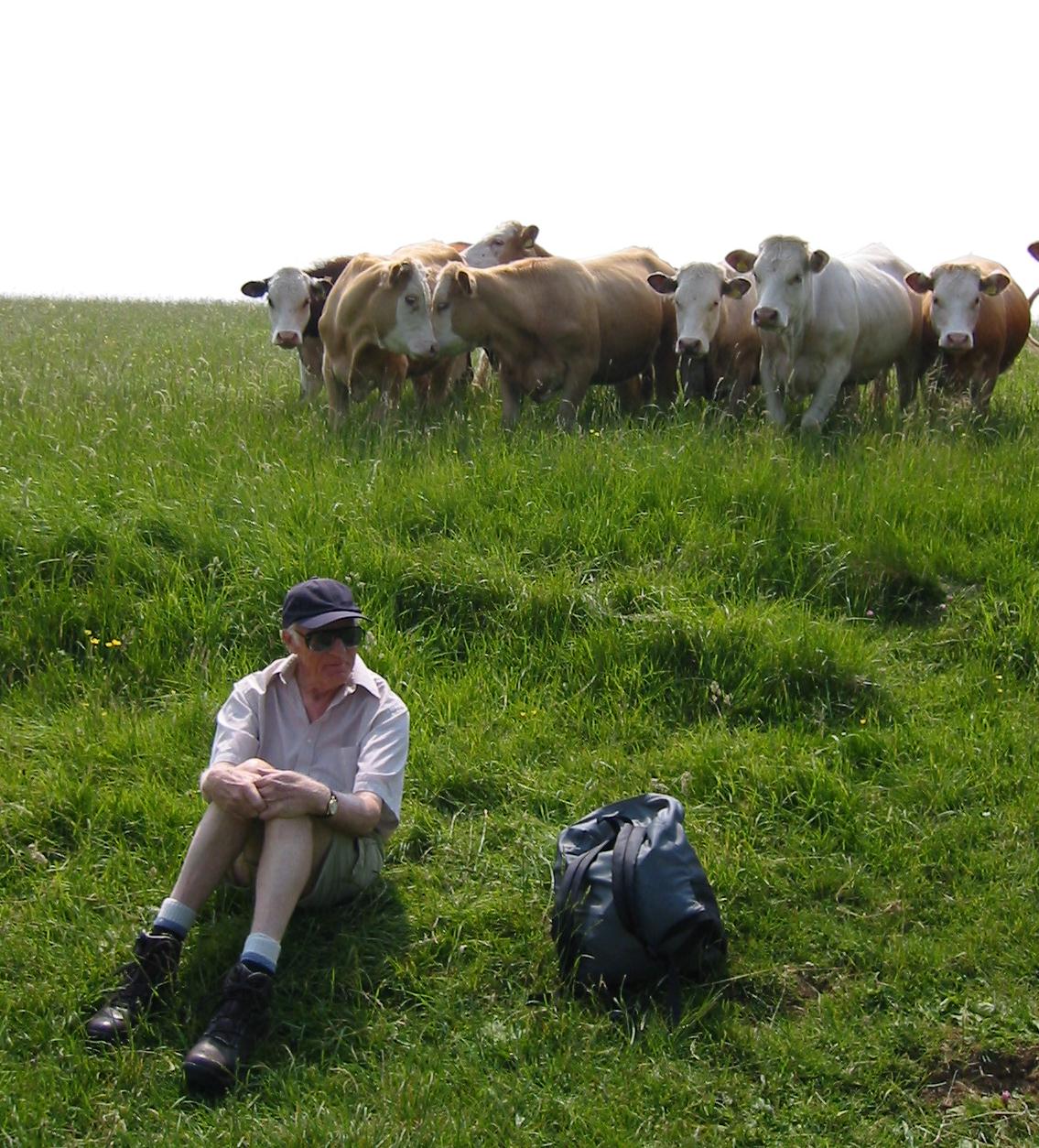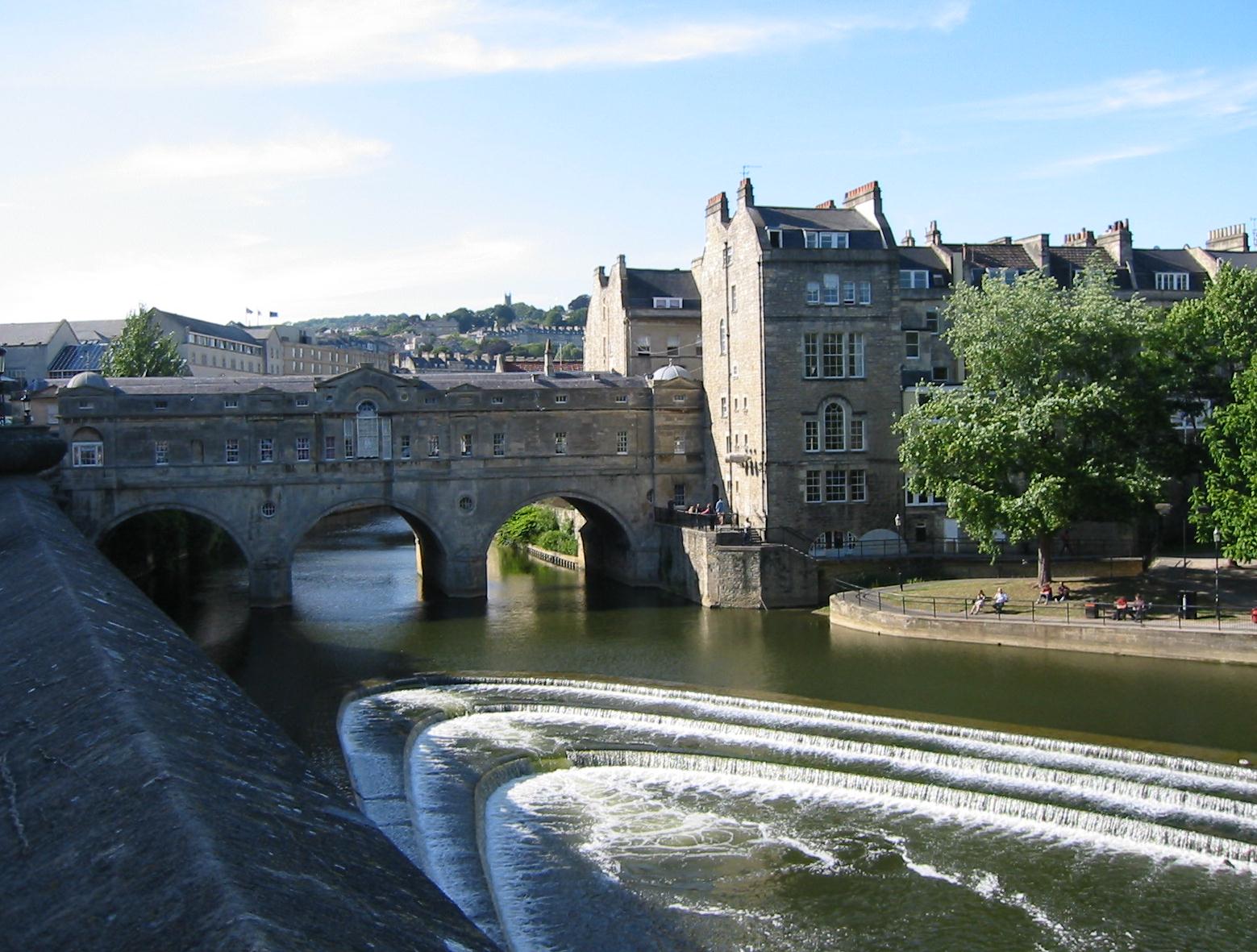June 17, 2003: Pennsylvania to Bath
The sun was having a harder struggle with the clouds this morning, the last day of our outing on the Cotswold Way. There had been a quarrel over breakfast time; I had wanted an early start, 8:00, and Tosh a later one, 8:30, but in the event Mrs. Mutlow had errands to run between 7:30 and 8:15, so the latter time was chosen for this ceremony. The Lees looked rather shell-shocked after a night on the Pennsylvania Turnpike.
We left at 9:15 but got no further than the petrol station – where we bought lunch materials and the Lees got their daily news fix. Then we had to wade through the rape again, with Margie going first; her black trousers fared far better than my lightly-colored pants had done the night before. I took a picture of Harold walking past the White Hart Inn and of Marge walking past the Cold Ashton church, which we reached along a track that was being surfaced with gravel as we walked it.
Overlooking a valley to the south, Cold Ashton was a quite lovely village. There were some impressive buildings, including a rectory and a manor house, and the gardens were resplendent. A plaque honoring the local horticultural society was evidence of the pride this village took in its flowers.
We made a right turn in Cold Ashton, heading west. This meant another crossing of the A46 and a lorry driver, observing our despair in the face of this never-ending torrent, came to a halt, holding up all the northbound traffic behind him, until a break in the oncoming lane allowed us to dash across – giving him a high sign of gratitude as we did so.
Our route now followed the Greenway Lane, a narrow tarmaced roadway that curved from west to south as it dropped down the hill. Hedgerows accompanied us and far above us was the manor of Hamswell, shining in the morning sun. Signs indicated that we would soon reach a special plants nursery and I knew that Tosh could not resist a visit –“Just remember,” I said, “everything you buy you have to carry.” In the event no purchases were made from the American lady in charge. There were a lot of strange cats about – it looked like too much inbreeding to me.
A catalogue in hand, Tosh at last made her farewell and we continued downhill, losing our lane at the entrance to a farmstead and crossing a stile that put us on a level path above a large pond. We then reached the barn at Lilliput Farm and faced a steep ascent, in stages, up the hill in front of us. A chap on his way down advised us that there would be a nice bench waiting for us at the top, courtesy of the local folk, and here we had another nice rest. There wasn’t quite enough space for four on the bench so Harold sat on the grass and someone shouted “Incoming bovine” as, indeed, a small herd of young males came to stare down at Harold as though he were an object of worship. Marge and I both reached for our cameras.
At the top of this rise we discovered a bridle track heading west and still climbing a bit, and I began searching the horizon for the promised Grenville Monument. We climbed over a stone fence at the top, still with no sightings, and entered a wood above a busy main road. Here the path dipped and rose to uncover the fenced monument in question – no tower this time at all, but a statue on a plinth celebrating a Royalist general. I had agreed to a rest here (it was close to noon) even though I supported the Parliamentarians.
We nestled down on the far side of the monument and I ate half an egg sandwich. I knew that we would have to join the road just below us and turn right on it, but it was fortunate that at this point I had a close look at the OS map in Burton’s book, realizing that we were still meant to use the path across the plateau before resorting to the road. If we had dropped down directly from the monument and turned right here we would have been well and truly lost. Our rest lasted only about fifteen minutes and during this time the sun disappeared and we had rather ominous grey skies for the next two hours. It was cooler this day than on the first four days of the expedition.
Once we had reached the road we were directed across it to join a parallel track that swung to the left and took us in the direction of a tall Fire Brigade communications tower. I paused here to check my directions carefully, pressing forward around the right side of this establishment and finding a path that dropped down to the nose of Hanging Hill.
Here we turned left and followed an overgrown field path that lead us up to another large golf course. The crossing of this flat hilltop refuge for the duffers of Bath seemed to have been altered slightly from that pictured on the OS map. For once, however, things were well waymarked – and we knew when to abandon a line of trees for a track that lead from one side of the course to the other and then turned right to accompany Pipley Wood. When the track began to drop we paused to have our official lunch; I finished my egg sandwich, ate a tuna one and drank a nostalgic bottle of Ribena strawberry juice while motorcyclists sped uphill in front of us.
It was still quite grey (no views of Bristol today) and we resumed our march downhill, leaving the track for a path through the grass on a shelf. Here we turned left and climbed back up to the summit plateau for more field edge scrambles in a southeasterly direction. I was looking closely for a turnoff to the right and I found it at Prospect Stile, which, true to its name, offered a panorama of hills and the first sightings of distant Bath. To add to our pleasure the sun was beginning to return to the skies.
A descent brought us down to a hedgerow, which we followed more or less (I told Margie she didn’t need to use one obviously overgrown, though waymarked dogleg). When we switched to the east side of the hedge we encountered a melancholy marble monument that marked the spot were a 17 year-old girl had died (riding accident?).
Tosh was worried that we would have to climb Kelston Round Hill but our trackway swept around below its summit. We were now making excellent time and this was just as well because we were aiming for a 4:30 rendezvous with Dorothy at our Bath hotel. Even Dean Hill did not require much of a rise on our part though we did pause for a final rest, staring down on the housing estates of Weston far below us. The others had a debate on whether those were sheep or children in the road below us. They were being herded, in any case, but their blue and yellow gym uniforms were perhaps a giveaway.
There now began a swift but steep descent down to the playing fields of Weston. A Jack Russell was here to greet us at our last stile and we then continued through parkland (Tosh picking up litter) to emerge on Penn Hill Road. Harold spotted a turnoff that led us down to the main road. Here he went into a chemist across the street for some Zantac for his stomach and I lead the rest of us into the Crown and Anchor pub for some refreshments. I had a Diet Coke while Tosh, who was fretting about the allure of alcopops, had a Smirnoff Black Ice. I had a sip; it was quite refreshing. There weren’t many people left in the pub, though one young couple (she in camouflage) were playing billiards.
The sun was out brightly and it was quite warm and we had slightly less than two miles to go as we crossed over to Church Street, walking though the churchyard in question, and proceeding steeply uphill. Tosh was now beginning to discover that the route planners, in order to give us a panoramic entry into Bath, had decided to send us steeply uphill first – though I had been warning of this development for days. An alley lead us to a suburban street which we took to the right, ignoring a CW arrow that had been twisted from its correct direction. I lost track of the flower inspectors for a while, climbing up another lane and turning right to return briefly to countryside. Here began a really steep pull, in two stages, to the heights. The second half of this walkway had been tarmaced recently and our boots made a sucking sound as we pulled them from its surface.
We reached Summerhill Road, turned left and then dropped down Sion Hill which, after a curve, put us into parkland opposite the distant Lansdown Crescent. We dropped down the hill under stately trees, crossed over to Victoria Park, turned left to pass the Victoria Monument and continued forward – with the famous Royal Crescent now on our left. I took a picture over the huge picnic scene before me. Then the road turned to the right and lead us down to a busy Queen’s Square.
The guidebook was useful in providing a series of short turns in a twisting trajectory aimed at Bath Abbey, the official end of the Cotswold Way. I wanted to line my troops up for a celebratory photo in front of this edifice but this would have meant their posing with their backs to a fiddling busker who occupied the forecourt – and they refused. “But he has his back to you; he won’t even see you.” “Yes,” one of them said, “but those watching him will see us.” I gave up and took a picture of the Abbey sans walkers. I pointed out that we had now walked the entire Cotswold Way without once encountering rain.
Harold knew Bath quite well and led us in a few more blocks to the Abbey Hotel; it was just 4:30 and we had walked eleven miles. We checked in and went to our rooms. I had a look out of the window of mine at the riverside scene below and spotted Dorothy, just entering the hotel. After some unpacking (she had brought some fresh clothes for me) I took a shower and then she and I tried to have a drink in our hotel (no draft beer) and thereafter we wandered about before sitting down in front of George’s Hotel for a refreshing drink in the late afternoon sun. Dorothy had been in Bath as well (it was my first visit) and pointed out several sights. We walked up to the Pulteney Bridge, for instance, and through many a pedestrianized shopping precinct – Bath was like a theme park for middle-aged culture vultures. I didn’t like all the panhandlers – who made snide remarks if you didn’t pay up.
We met the others at 7:00 and Harold lead us to another hotel (ours was a bit shabby: no minibar), and we had drinks and nuts in the lounge of the Francis. Shortly before 8:00 we continued on to George Street where Dorothy had reserved a table for five at the famous Hole in the Wall. So we had a festive celebratory meal, returning in darkness to our hotel. The police were arresting an obstreperous citizen.
We were now really operating independently of the others – since I wanted to so some sightseeing the next day and they were not returning to Paddington anyway, but we ran into them at breakfast and at check out – after Dorothy and I had spent an hour at the famous Roman baths. (Our own packing was a bit substandard since Dorothy had tidied away a number of items from my pack by hanging them in the closet, and the hotel had to mail them to us the next day!) The Lees and Margie were at the train station too – we all left on the 10:52 and they waved as they departed this train in Reading. Our train began to slow down as we neared the end, arriving fifteen minutes late. We took the tube home and within a few hours I had made final arrangements to use the next morning to pick up our new puppy, Fritz!
Footpath Index:
England: A Chilterns Hundred | The Chiltern Way | The Cleveland Way | The Coast-to-Coast Path | The Coleridge Way | The Cotswold Way | The Cumberland Way | The Cumbria Way | The Dales Way | The Furness Way | The Green London Way | The Greensand Way | The Isle of Wight Coast Path | The London Countryway | The London Outer Orbital Path | The Norfolk Coast Path | The North Downs Way | The Northumberland Coast Path | The Peddars Way | The Pennine Way | The Ridgeway Path | The Roman Way | The Saxon Shore Way | The South Downs Way | The South West Coast Path | The Thames Path | The Two Moors Way | The Vanguard Way | The Wealdway | The Westmorland Way | The White Peak Way | The Yorkshire Wolds Way
Ireland: The Dingle Way | The Wicklow Way
Scotland: The Great Glen Way | The Rob Roy Way | The Speyside Way | The West Highland Way
Wales: Glyndwr’s Way | Offa’s Dyke Path
Channel Islands: The Guernsey Coastal Walk | The Jersey Coastal Walk



